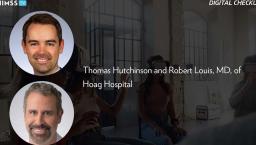Machine learning helps cancer center with targeted COVID-19 outreach

Regional Cancer Care Associates, Olney, Maryland
Regional Cancer Care Associates, based in New Jersey, has more than 20 locations throughout New Jersey, Connecticut, Maryland, Pennsylvania and the Washington area. Staff realized they needed a risk-stratified list of patients for COVID-19 vulnerability that nurses could manage through phone calls and by coordinating services with other providers.
THE PROBLEM
Because of staffing challenges, the list had to identify only the high-risk patients who staff needed to manage first, not the entire population or those patients who could wait a bit longer for nurse outreach.
"Even though we already had an indigenous and independent scoring logic/mechanism for patient risk, this was mainly based on a combination of comorbidities that differentiated it from the usual scoring techniques," explained Lani M. Alison, vice president of quality and value transformation at RCCA.
"Thus," she said, "there was a need to further stratify the risk patients for COVID-19 vulnerability and to establish a patient-centered assessment and outreach."
On another note, staff observed challenges in assigning these patients and a defined patient roster to care coordination executives or support staff, which was hindering a patient-centric outreach approach, Alison added.
PROPOSAL
RCCA turned to artificial intelligence-based health IT vendor Health EC to help address the challenges.
"HealthEC was able to run their machine learning algorithms to identify the patients at highest risk for COVID-19 and therefore focus our care coordination resources," Alison said. "Algorithms re-stratified these patients and assigned a ranking to each patient with an associated risk score."
"Embedding and onboarding of data from multiple sources, like EHRs, HIEs, claims, CCDAs, etc., was a big plus to provide caregivers easy access to all types of data in one single place."
Lani M. Alison, Regional Cancer Care Associates
The result was a defined patient list that enabled the RCCA team to reach the highest of the high-risk population. The list proved very helpful, and it became an essential part of RCCA's care management documentation platform. It helped focus initial care management calls and increase the effectiveness of the team.
"RCCA also used the list to streamline the COVID-19 huddles and provide this information to practice administrators at each of our sites to help manage patient outreach, mitigate the risk and provide educational information," she said.
MEETING THE CHALLENGE
Data was aggregated from claims, clinical, labs and HIE data sources into the universal data warehouse used by HealthEC. This created a longitudinal, 360-degree view of the patient.
"This single longitudinal view gave us easy access to all the patients' care records and pooled data, including demographics, vitals, diagnosis, etc., from different sources, like the EHR, claim files, CCDAs and ADTs," Alison explained.
"Users were able to have access to patient clinical information without jumping around into different modules. It created a one-stop shop."
HealthEC's Care Connect Pro empowered RCCA staff to stratify high-risk patients (10% of its entire population), not only for COVID-19 risk management, but also for better care management overall, she said.
"Care coordinators, nurses and staff used the CCPro tool to document patient outreach, education material and medication management," she said. "Each patient was assigned a dedicated care coordinator to help mitigate the risk of hospitalization."
Along with the aforementioned clinical data, diagnostic information was added for integrated patient care plans with LabCorp data. This ensured a real-time dynamic flow of information that proved crucial for physicians to design a care pathway or to decide the next milestones of a care plan, she added.
Data received from CRISP – the Chesapeake Regional Information System for our Patients, the area's HIE – was also processed and synchronized into the system to ensure real-time availability of admissions and discharge information.
That is all part of phase one: patient identification. Phase two is interventions and outcomes. This phase requires RCCA staff to:
- Establish patient contact, outreach and follow-up triage.
- Use clinical pathways to standardize care and improve patient-reported outcomes.
- Increase patient satisfaction and decrease costs.
- Close care gaps to improve on quality measures and keep track of KPIs.
- Measure outcomes using quality measures and gap analysis.
- Keep a high rate of life expectancy and higher quality for end-of-life patients.
- Manage end-of-life patient engagement using survivorship plans.
RESULTS
RCCA reports success with three key metrics.
First, billable transitional care management and chronic care management services now live in some of the practices.
"With targeted patient outreach, patient-specific CCM and TCM, and customized COVID-19 assessments, services were made available to patients after running rigorous risk-stratification protocols to filter out high-risk patients; 10% of the identified entire high-risk population for COVID-19 was validated by the practice by outreach and tele-connections," Alison explained.
Second, improvement in pain and advance care planning measures.
"We had timely interventions to close care gaps," Alison said. "The ACP measure requires patients to report the status of pain within 48 hours. The real-time pain assessments and scores help to close care gaps and ensure the patients are contacted within a specific time interval, 48 hours, to ensure patients' pain was brought to comfortable levels and satisfy the measure compliance."
And third, access to CRISP (Maryland's health information exchange) proved to be a game changer for the provider organization.
"Ease of integration was key," Alison said. "Embedding and onboarding of data from multiple sources, like EHRs, HIEs, claims, CCDAs, etc., was a big plus to provide caregivers easy access to all types of data in one single place."
ADVICE FOR OTHERS
"Targeted patient outreach using preprocessed and intuitive data sets formed as a result of the summary of various clinical and nonclinical information can help optimize the utilization of staff or resources and thereby ensure better care outcomes and patient satisfaction," Alison advised.
"Inferences from data analytical tools work best in scenarios where data flow is not intermittent but continuous, real-time and unbiased, or deduplicated," she said. "In order to derive definitive insights that can help in decision-making and planning for the organization, the quality and quantity of data inputs is very critical."
Twitter: @SiwickiHealthIT
Email the writer: bsiwicki@himss.org
Healthcare IT News is a HIMSS Media publication.
























